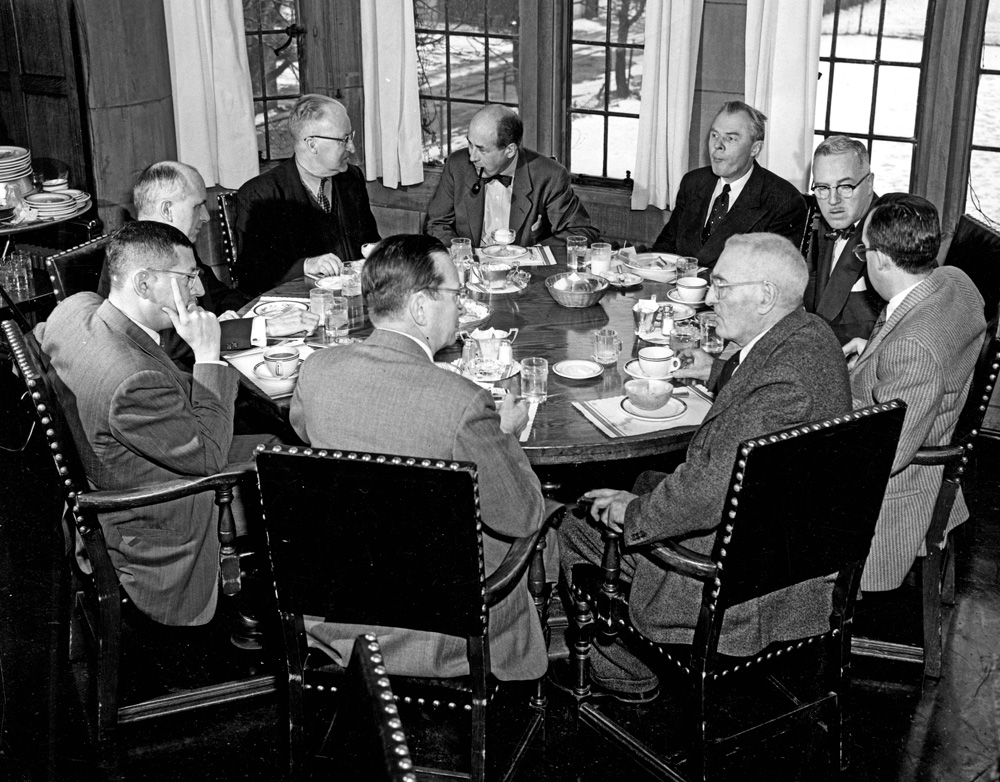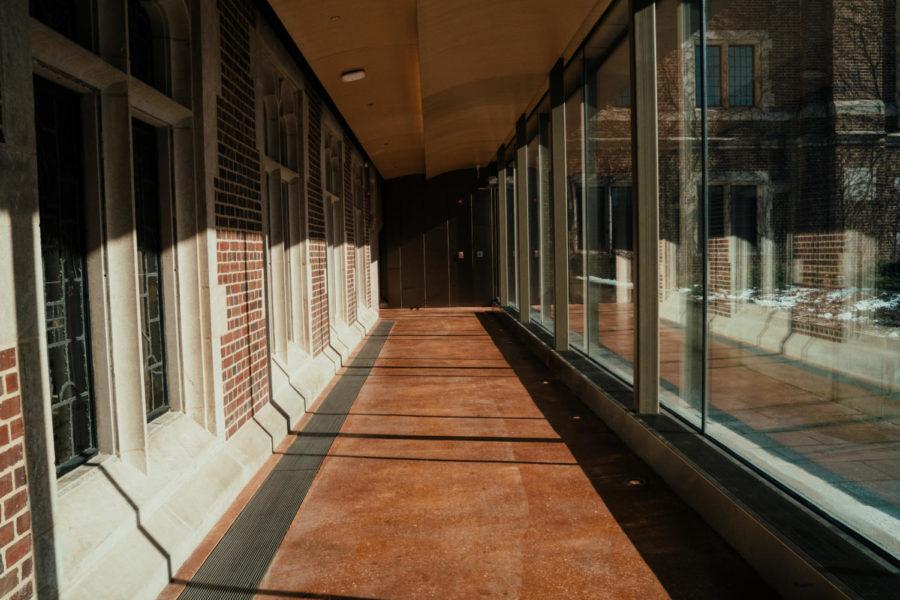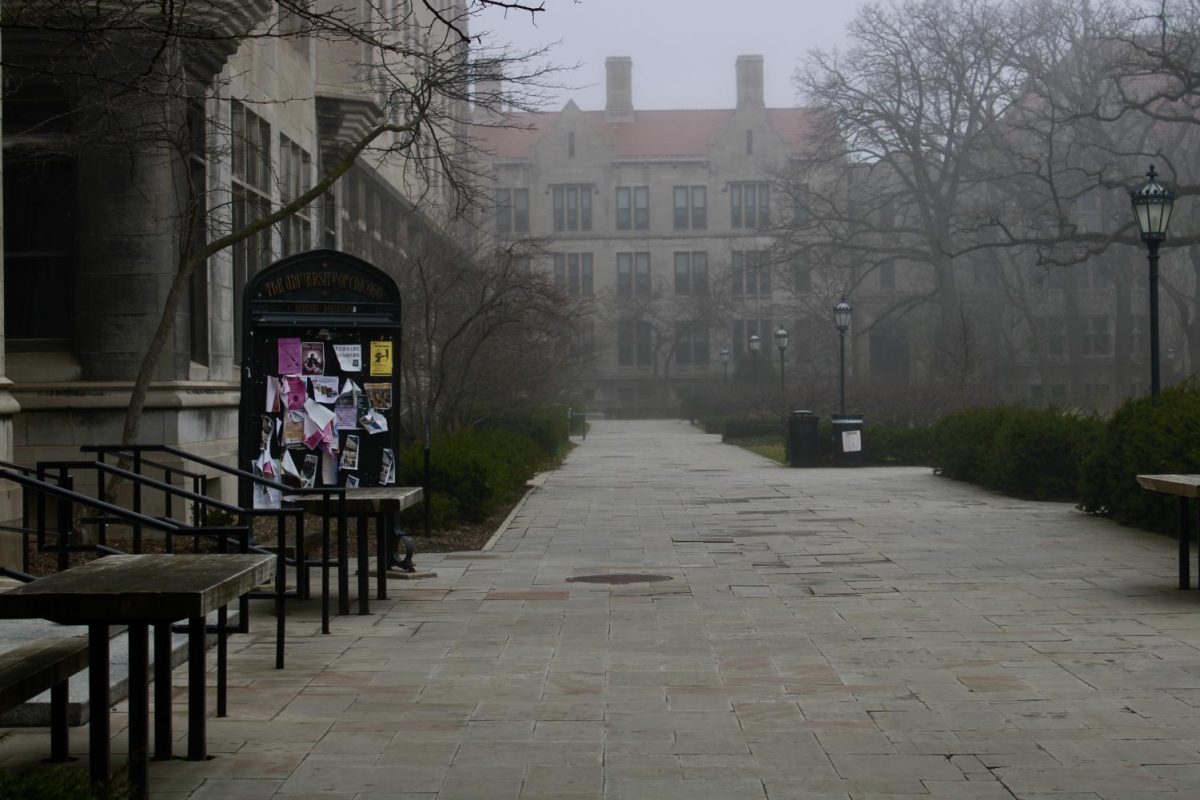In the previous article in this series, we examined faculty concerns over the Grossman Institute and private capital backing ambitious projects at the University. Here, we look at what happened when faculty attempted to assert control over these institutes.
Quotes and attributions in this article, unless otherwise noted, are taken from minutes of the Council. The Council’s discussions are paraphrased in the minutes, and Council members vote at each meeting on whether to approve the previous meeting’s minutes. Speakers therefore have a chance to contest or revise the way their comments are paraphrased. Still, the minutes should not be read as direct quotes, or as perfect reproductions of conversations that took place. More information about the minutes and Council can be found here.
Provost Daniel Diermeier arrived at a faculty meeting at the School of Social Service Administration (SSA) in December 2018 to announce a major restructuring: The SSA would merge with the Urban Education Institute (UEI), which researches education policy and operates a teacher training program and charter school network.
The faculty at SSA were not consulted before Diermeier made that announcement. And, since the change was announced, they have had little say in how it would be implemented. Following Diermeier’s announcement, some worried the incorporation of the Institute would skew the small School’s research heavily toward education. The SSA, they said, has succeeded by not being dominated by any one discipline.
The way Diermeier responded to faculty concerns at the December 2018 meeting, SSA professor Bill Sites recently told The Maroon, was “implicitly threatening to SSA, or it was condescending.”
“A couple of faculty raised questions, and his response, in so many words, was: ‘That will be worked out later, don’t worry your little head, we’ll take care of everything,’” Sites said.
The merger of UEI and SSA is the latest instance of a long pattern of faculty members being kept out of decision-making over the research centers, institutes, and non-degree-granting units scattered across the University. These entities have proliferated over the last two decades, and some professors say that they are both a symptom and a cause of eroding faculty governance.
Currently, the Council of the University Senate, the body elected to represent faculty, is not permitted to vote on the creation of these entities.
Professor Na’ama Rokem, the spokesperson for the Council’s seven-person Committee, describes the set of issues currently under the faculty’s authority as far too narrow. As spokesperson, Rokem is the highest-ranking member of faculty government.
“If we wanted to pass a vote just saying, ‘As the body representing the University, we feel this is a bad plan’—we couldn’t do that, under the way the Statutes are being implemented now,” Rokem told The Maroon.
By contrast, the faculty at many top universities have considerable discretion to constrain their central administrations and register approval or dissent. At Stanford, the faculty senate—whose agenda and minutes are publicly available—recently voted to support proposals of Associated Students of Stanford University, a student group. At New York University, the faculty can issue a vote of no confidence in the president, as they did in 2013.
Rokem joined more than 100 colleagues last month in signing a letter to administrators expressing “grave concern” over the manner in which consultative governance has been restricted. She worries the faculty senate is directed away from discussing thorny issues like donor-backed institutes and centers.
“Given that as an institution, our stated ethos is that we believe there should be robust debate,” Rokem told The Maroon, “the fact that it’s very difficult to bring things up for debate in this forum seems to contradict that stated ethos.”
Institutes proliferate over the last two decades
The more than 100 institutes and centers at the University span an eclectic mix of entities: modest pots of money earmarked for neglected fields in the Humanities; cutting-edge collaborations in the medical school; affiliates of Argonne National Laboratory. These have long been a part of the school’s ecosystem.
Likewise, wealthy donors are nothing new to a University founded by John D. Rockefeller. But whereas Rockefeller was remote and hands-off—pleased to let the University pursue its own research aims—the past two decades have seen new and aggressive proposals directed at specific ends, faculty critics say.
In addition to the Milton Friedman Institute (now Becker Friedman), the 2010–11 academic year saw the opening of the Institute in Law and Economics (adopted by a donor in 2013, and renamed the Coase-Sandor Institute) and the Fama-Miller Center for Research in Finance, closely followed by the Center for the Economics of Human Development in 2014.
Some institutes are public-facing, inviting businesspeople and experts to campus, forging connections between students and public figures.
The Polsky Center for Entrepreneurship and Innovation, which was bumped up from a program at Booth business school to a freestanding institute in 2016, connects students and faculty with venture capital. The Center, a notice by the University's communications department announced, would help “combine and expand entrepreneurial efforts that are separate at most universities.”
UChicago’s Institute of Politics (IOP), founded in 2013 by Obama strategist David Axelrod, hosts events with politicians. Since the IOP’s opening, UChicago has become home to numerous other politics-related initiatives: the Project on Political Reform (2014), the Chicago Center on Democracy (2018), and the Center for Effective Government (2019).
Other institutes have names so all-inclusive they sound like the generic description of a university.
The Knowledge Lab explores “how knowledge is made, used, certified and forgotten.” It is part of the Metaknowledge Research Network, a research initiative that studies knowledge. The Center for Practical Wisdom, meanwhile, is geared at understanding “how to gain, reinforce, and apply wisdom.” Housed in the Department of Psychology, this center was founded in 2016 with a grant from the Templeton Foundation, which sponsors findings linking Christianity to science.
The Stevanovich Institute on the Formation of Knowledge, whose director classicist Shadi Bartsch is married to University President Robert Zimmer, aims to “understand how factors like history, politics, culture and religion can shape knowledge.”
Special projects like the Institute for Molecular Engineering, recently inaugurated as a school of molecular engineering, have helped the University to poach top talent.
While many centers and institutes are founded with high-profile donations, others are allocated funding by the University. They are “net consumers of resources,” former provost Thomas Rosenbaum told the Committee of the Council in 2011.
This trend is not confined to the University of Chicago. Many elite research universities increasingly focus on fundraising for interdisciplinary institutes helmed by academic superstars. Research centers can be attractive to faculty because they often bypass the snarl of divisional funding, and posts may come with fewer teaching responsibilities.
Stanley Katz, a Princeton historian of philanthropy and higher education who previously taught at UChicago, told The Maroon that the tendency to create institutes arose from a perceived need “to make campuses more appealing to the most competitive and productive faculty members.” The trend is also driven by donors impatient for quick results, Katz said, adding that independent institutes are attractive to philanthropists because research is more easily directed toward pet projects.
Council debates the rise of institutes
When Katz sat on the Council in the 1970s with then President Edward Levi, faculty vigorously debated proposed changes, he said. Professors generally felt they had real power to steer the direction of the University.

“You need to compare somebody like President Zimmer with somebody like Edward Levi, who was the president when I was there. Edward was a very different sort of person—he was a very old-fashioned sort of person, somebody for whom intellectual quality was the only thing that mattered,” Katz said. Under Levi, “very often, we came to decisions I didn’t like, didn’t approve of. But, boy, they were always carefully considered.”
Decades later, the picture is much different.
As institutes proliferated, concerns over faculty jurisdiction over them intensified, coming to a head with disputes over the Friedman and Grossman institutes. Following the controversies, in 2012, it was unclear to many faculty members whether the Council had jurisdiction over these institutes.
Some faculty cited the general interest clause in the University statutes, which grants the Council jurisdiction over “any action of any Ruling Body which substantially affects the general interest of the University,” to argue that research institutes fall under their jurisdiction.
Others described potentially detrimental results if the Council used the general interest clause to enlarge its turf.
Then-provost Rosenbaum, now the president of the California Institute of Technology, described his concern that if the general interest clause were too loosely interpreted, “the outcome may result in tying the University up in knots.” Ambitious initiatives aimed at big problems, he said, “would run the risk of being voted down because different groups of faculty were voting against each other.”
Michael Schill, then dean of the Law School, argued that requiring faculty approval for new institutes could discourage donors from giving money. (Schill has since left the Law School to become president of the University of Oregon.)
Citing his experience as a dean at the University of California, Los Angeles, Schill praised faculty governance as a value but stipulated that “shared governance can have costs which need to be weighed against benefits.” Given the increasing amount of academic activity requiring interdisciplinary partnership, “if there was a requirement for Council approval for every non-degree-granting research program that was proposed, this would slow down the process and introduce additional layers of insecurity.”
“In turn,” Schill explained, “this could create uncertainties among potential donors, and lead to a reduction in philanthropic support.”
In response to the debates, Zimmer charged three committees with examining the issue:
- The 12 deans.
- The Topel/Markell Committee: A group of Council members picked by the Committee of the Council. The faculty selected were Robert Topel, Yali Amit, Patchen Markell, David Meltzer, L. Ridgway Scott, A. Holly Shissler, and Robert Kendrick.
- The Pippin Committee: A group of faculty picked by Zimmer. The faculty selected were Robert Pippin, Andrew Abbott, Michelle Le Beau, Raghuram Rajan, Anne Walters Robertson, Stephen Stigler, and David Strauss. The report they produced is commonly referred to as the Pippin Report.
It would be up to Zimmer which committee’s recommendations to heed. “It is ultimately my responsibility as President of the University to decide upon the recommendations on this matter, with the advice of the Provost,” he wrote in a January 2012 letter to faculty.
Topel Committee Report
The Topel Committee—the committee staffed by members of the Council—achieved some consensus, but remained divided over several key points.
In a memo prior to the final report, Markell, Shissler and Amit argued that in some cases, academic freedom—the same principle usually invoked to restrict the Council’s authority—might in fact demand that the Council intervene in research-related matters.
One concern brought up during their deliberations, they wrote, “is that the proliferation of research institutes and centers without appointive power…has begun to erode the ability of local, self-governing units—departments—to set their own intellectual agendas, shifting power within the University toward the center, or toward some subsets of faculty at the expense of others.”
This report and related memos can be read as PDFs at the bottom of this article.
Pippin Report
The report of the committee chaired by philosophy professor Robert Pippin, which has been cited in more recent disputes over the extent of the Council’s authority, warned against potential harm to academic freedom if the Council is granted too much latitude.
All was well, it explained, with University governance.
“Remarkably few substantive discussions or disagreements about University governance have arisen since the current organization was formed in 1944. This is further evidence that the governance structure and our past practices are functioning well and are not in need of revision…”
The University had changed drastically in recent years, the report acknowledged, but the governance structure remained adequate to the complex modern institution.
“Even during times of an activist administration, one that facilitates the formation of units considerably larger than before, commits more university resources than before, and helps create significantly more research Institutes and Centers than before, the process of faculty vetting has remained, and should remain, the same.”
Indeed, the right of academics to chart the course of their own research, independent of Council review, had become “even more important in an era when sub-disciplines and trans-disciplinary research opportunities have exploded in number and kind.”
None of the reports was ever formally endorsed by the Council.
But the administration now treats the Pippin Report as precedent. Last year, Diermeier cited the Pippin Report as authoritative in a dispute with faculty, arguing that the issue of graduate student unionization did not fall within their voting authority.
The Pippin Report can be read as a PDF at the bottom of this article.
Reception of the reports
Historian of religion Christian Wedemeyer said the Pippin Report seemed to be arguing against “imaginary threats.” Those who were advocating “unchecked administrative authority”—like Pippin’s committee—had misrepresented those who wanted to extend the Council’s jurisdiction, he said.
“The credulous reader comes away from this report thinking that the Council is actively seeking to lurk in their offices, look over their shoulders, and micro-manage their research, taking away their “academic freedom,”” Wedemeyer told the Council.
To Wedemeyer, the “extreme” position was Pippin’s argument that the Council should be prevented from voting to express “unbinding, advisory opinions on vital matters of general interest to the University.”
“Academic freedom does not include the absolute right to set up formal research institutes bearing the name of the University,” Wedemeyer said.
To other faculty, it seemed as though the controversy over research centers and Council jurisdiction had been a proxy debate over Zimmer’s active administration.
Neuroscientist Daniel Margoliash described an “underlying context that he felt was somewhat uncomfortable to discuss. He pointed out that over the past few years there had been a very active and effective administration in place, led by Messrs. Zimmer and Rosenbaum, and this level of activity had generated some concern among the faculty, as well as questions regarding the existence of an appropriate mechanism for faculty response and input.”
Muddling through the SSA–UEI merger
In response to questions about institutes and centers, Zimmer told the Committee of the Council at a meeting in October 2011 that he thought “issues have arisen because most faculty are not aware of the scope of University operations.”
The solution, Zimmer said, would be more dialogue: “open discussion might improve trust.”
A decade later, faculty members feel that dialogue has not occurred—if anything, some say, it has been cut back.
Following the recent announcement that the UEI would be taken over by the SSA, faculty scrambled to figure out what the tie-up would mean for the two units.
The SSA, founded in 1920, is a degree-granting school; UEI, launched in 2016, manages a number of discrete education-related programs. Some SSA faculty members expressed political objections to the charter schools under UEI’s management; others voiced concerns about whether SSA would be financially on the hook for the success of the program.
“Faculty spent an enormous amount of time trying to map out what could possibly be the financial, the intellectual, the organizational implications of bringing these two units together, and how it might affect us,” Sites told The Maroon. “They were all pretty inconclusive. And the reason they were inconclusive is because, throughout, it was pretty clear that faculty were playing no role in governing this process.”
Administrators were clear on one point, however: don’t call the move a ‘merger.’
The provost and others “emphasized that SSA would become the academic home of UEI,” Sites said. “We were repeatedly instructed to no longer use the word merger.”
For this story, The Maroon requested to speak with President Zimmer and Provost Diermeier. In response, University spokesperson Jeremy Manier wrote:
“Thank you for inquiring about the Urban Education Institute (UEI) and the School of Social Service Administration (SSA). SSA became the academic home for UEI as of July 1, 2019. Although you used the term “merger” in your email, that is not accurate. Moving UEI under the organizational structure of SSA established a stronger connection between SSA and UEI, enabling opportunities to enhance and amplify existing expertise in public education research and policy, and to pursue new opportunities for collaboration in the important areas of poverty reduction, violence prevention, protecting vulnerable children and families, and providing high-quality education.”
2012 debates over jurisdiction of the Council:
Topel Report and memos:
Pippin Report:









